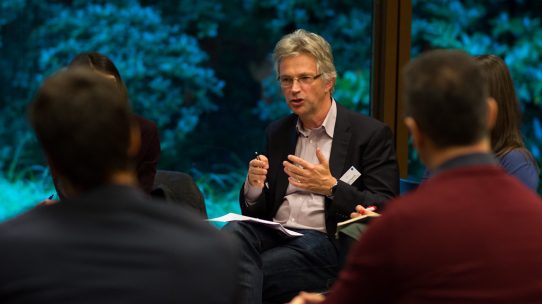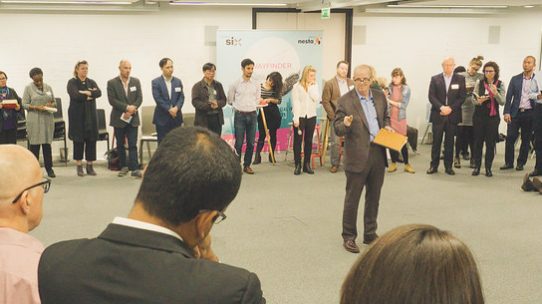If I had to pick just one thing that makes social innovation work, it would be collaboration.
And if I had to pick just one thing that Canada does particularly well?
Well, it’s collaboration—our small population in a huge country, we have had to work together because, let’s be honest, we’re really nice.
The world loves to joke about how nice Canadians are. We hold doors open for too long, we apologize when someone bumps into us, and we’ll go out of our way to help a stranger. But maybe, this niceness isn’t just a quirk, maybe it’s actually our secret weapon when it comes to social innovation.
Being Nice = Deep Listening = Better Relationships = Better Solutions
At its core, social innovation is about solving complex problems. And the only way to do that is by building strong relationships.
Good ideas don’t exist in isolation. The best solutions emerge from deep listening, trust, and meaningful collaboration. Social innovation relies on bringing together different perspectives—those who experience problems firsthand, those who have resources, those who see the system as a whole—and figuring it out together.
And we’ve had to get good at that.
Innovation (and Survival) Through Relationships
Collaboration isn’t just part of our culture—it’s part of our survival strategy.
From the very beginning, relationships determined whether people thrived or perished in what is now called Canada. Indigenous peoples shared their knowledge, resources, and ways of living with settlers—literally keeping them from starving and freezing to death. Without Indigenous teachings on food, medicine, and the land itself, there wouldn’t have been a Canada at all.
And yet, initially, those relationships were not respected in return, this is an area where we definitely failed to be nice. Colonization, displacement, residential schools, and broken treaties severed ties instead of strengthening them. But today, in an era of reconciliation, we are learning—and unlearning—what it truly means to build relationships based on respect, reciprocity, and shared leadership.
This matters because relationships are the foundation of all innovation. Without them, we don’t build trust. Without trust, collaboration fails. Without collaboration, we end up with fragmented, short-term solutions instead of deep, systemic change.
From SiG to SIX to SI Canada: Collaboration in Action
Canada’s social innovation sector has always been shaped by global and local collaboration.
For years, Social Innovation Generation (SiG) worked alongside Social Innovation Exchange (SIX) to bring the best of international thinking to Canada while sharing Canadian experiences with the world. Through global knowledge-sharing, policy conversations, and public sector innovation, SiG helped build the foundations of the social innovation field here in Canada.
This legacy continues today. Social Innovation Canada (SI Canada) builds on SiG’s work, but with a deeper focus on community-led, place-based, and systems change efforts. We are shifting from proving that social innovation matters to embedding it into how Canada tackles its biggest challenges.
Canada’s social innovation ecosystem has grown immensely. There are dozens of social innovation labs across the country, working on everything from climate action to refugee settlement to food security. Universities are integrating social innovation into research and curriculum. More governments, foundations, and private sector players are recognizing that big problems require collaborative, systems-level solutions.
And yet, the next phase of social innovation in Canada isn’t just about more labs or more networks. It’s about deepening impact, shifting power, and making collaboration more radical, not just nice.
From Niceness to Necessity: A New Approach to Housing & Clean Energy
Collaboration isn’t just something we do because we’re nice—it’s because it works.
Take housing. Canada’s housing crisis has demanded an all-hands-on-deck approach. For decades, housing was treated primarily as a market-driven issue, but today, we recognize it as a systems challenge that requires governments, finance, community organizations, and industry to work together.
Programs like the CMHC Solutions Labs and the Housing Supply Challenge weren’t just about funding projects—they fundamentally changed how we think about, regulate, and finance affordable housing in this country. These initiatives brought policymakers, developers, non-profits, and people with lived experience together, not just to propose quick fixes, but to understand the root causes of the housing crisis and develop solutions that are actually scalable.
This collaborative approach has reshaped housing policy, introduced new regulatory tools, and made social finance a critical lever for transformation. Today, we’re seeing more mission-driven housing funds, new ways of financing non-market housing, and government partnerships that move beyond short-term subsidies to structural change.
And it’s not just housing—Canada is also punching above its weight in clean energy and climate innovation.
The term “cleantech” was coined by a (very nice) Canadian named Nicolas Parker. Canada has long been a leader in environmental innovation, and today, we’re one of the top countries for cleantech development and investment.
Indigenous-led clean energy projects are at the forefront of this transition. The Indigenous Clean Energy Initiative and projects like Wataynikaneyap Power—the largest Indigenous-led infrastructure project in Canadian history—are transforming how remote communities access renewable energy. These projects are not just about sustainability; they’re about energy sovereignty, economic development, and self-determination.
At the same time, Canada has become a hub for climate-focused social finance, cleantech startups, and impact investment. The Canada Growth Fund, government-backed investment initiatives, and major private sector commitments are helping scale low-carbon solutions that will shape the economy of the future.
It’s proof that when we bring diverse voices together and commit to deep collaboration, we don’t just solve problems—we change the way the system works.
Collaboration Is Hard (But Niceness Helps)
Let’s be honest—collaboration is messy. It’s slow. It requires patience, trust, and an ability to work across difference. It’s also the only way we will ever solve the biggest challenges of our time, from housing and climate change to economic inequality.
But collaboration isn’t just about working together—it’s about working together in a way that actually creates impact. That’s where radical collaboration comes in.
Radical collaboration is what happens when we stop treating teamwork as a nice-to-have and start treating it as an essential systems-changing practice. It means:
Moving beyond transactional partnerships to deep, long-term relationships
Creating space for discomfort and hard conversations
Shifting from listening to real co-creation
Sharing power and recognizing many kinds of knowledge as equally valuable
Designing solutions with communities, not just for them
And you know what? That kind of collaboration is not easy. It’s uncomfortable. It requires people to check their egos, challenge their own assumptions, and stay in the work even when it gets frustrating.
But Canadians are uniquely positioned to do this well. Why? Because we have a history of doing it. We have a culture that values making space, hearing diverse perspectives, and seeking common ground. And while we don’t always get it right, we know that big, systemic change doesn’t happen without it.
Just One Thing? Collaboration.
So if there’s just one thing I want people to know about Canada and social innovation, it’s this:
We take collaboration seriously. Not just because it’s effective.
Not just because we’re nice.
But because, in Canada, collaboration is how we innovate, how we build, and how we survive.
And that’s something worth saying “sorry, not sorry” about.






